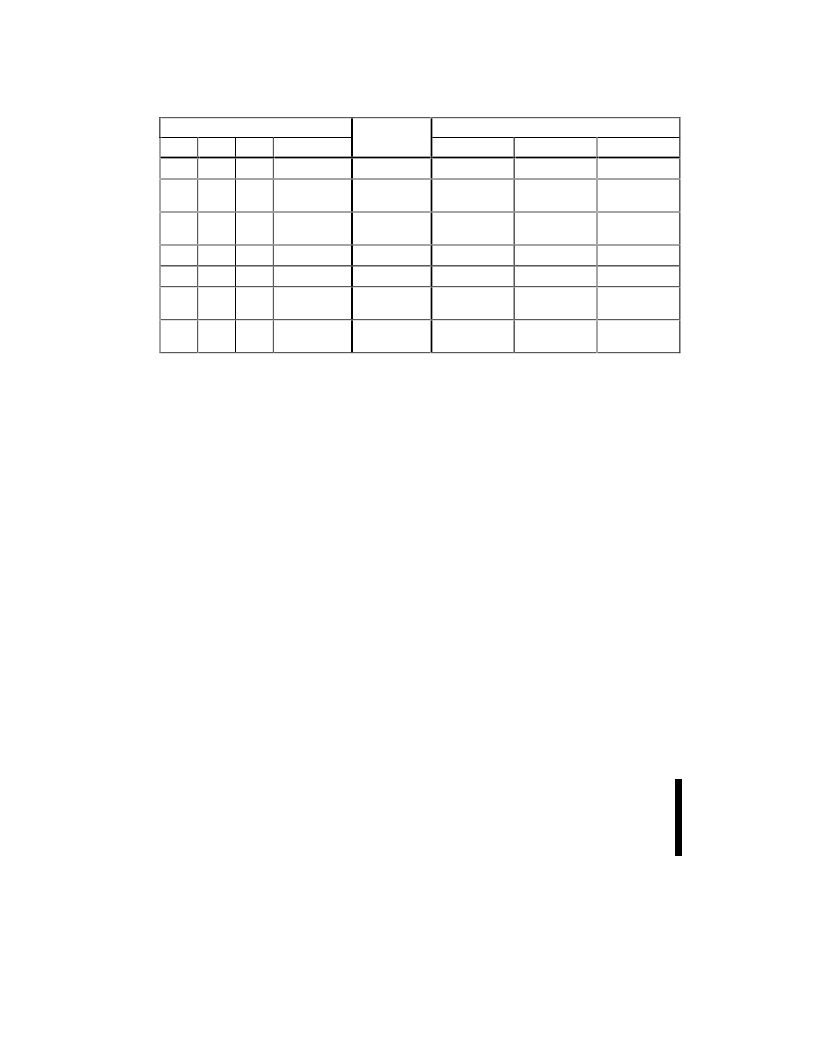- 您現(xiàn)在的位置:買賣IC網(wǎng) > PDF目錄371435 > 28F1602C3 (Intel Corp.) 3 Volt Advanced+ Stacked Chip Scale Package Memory(3V閃速存儲器和靜態(tài)存儲器) PDF資料下載
參數(shù)資料
| 型號: | 28F1602C3 |
| 廠商: | Intel Corp. |
| 英文描述: | 3 Volt Advanced+ Stacked Chip Scale Package Memory(3V閃速存儲器和靜態(tài)存儲器) |
| 中文描述: | 3伏高級堆疊芯片級封裝存儲器(3V的閃速存儲器和靜態(tài)存儲器) |
| 文件頁數(shù): | 18/62頁 |
| 文件大?。?/td> | 538K |
| 代理商: | 28F1602C3 |
第1頁第2頁第3頁第4頁第5頁第6頁第7頁第8頁第9頁第10頁第11頁第12頁第13頁第14頁第15頁第16頁第17頁當(dāng)前第18頁第19頁第20頁第21頁第22頁第23頁第24頁第25頁第26頁第27頁第28頁第29頁第30頁第31頁第32頁第33頁第34頁第35頁第36頁第37頁第38頁第39頁第40頁第41頁第42頁第43頁第44頁第45頁第46頁第47頁第48頁第49頁第50頁第51頁第52頁第53頁第54頁第55頁第56頁第57頁第58頁第59頁第60頁第61頁第62頁

28F1602C3, 28F3204C3
E
18
PRODUCT PREVIEW
Table 8. Block Locking State Transitions
Current State
Erase/Prog
Lock Command Input Result [Next State]
WP#
DQ
1
DQ
0
Name
Allowed
Lock
Unlock
Lock-Down
0
0
0
“Unlocked”
Yes
Goes To [001]
No Change
Goes To [011]
0
0
1
“Locked”
(Default)
No
No Change
Goes To [000]
Goes To [011]
0
1
1
“Locked-
Down”
No
No Change
No Change
No Change
1
0
0
“Unlocked”
Yes
Goes To [101]
No Change
Goes To [111]
1
0
1
“Locked”
No
No Change
Goes To [100]
Goes To [111]
1
1
0
Lock-Down
Disabled
Yes
Goes To [111]
No Change
Goes To [111]
1
1
1
Lock-Down
Disabled
No
No Change
Goes To [110]
No Change
NOTES:
1.
In this table, the notation [XYZ] denotes the locking state of a block, where X = WP#, Y = DQ
, and Z = DQ
. The current
locking state of a block is defined by the state of WP# and the two bits of the block lock status (DQ
0
, DQ
1
). DQ
0
indicates if
a block is locked (1) or unlocked (0). DQ
1
indicates if a block has been locked-down (1) or not (0).
At power-up or device reset, all blocks default to Locked state [001] (if WP# = 0). Holding WP# = 0 is the recommended
default.
The
“Erase/Program Allowed” column shows whether erase and program operations are enabled (Yes) or disabled (No)
in that block’s current locking state.
The “Lock Command Input Result [Next State]” column shows the result of writing the three locking commands (Lock,
Unlock, Lock-Down) in the current locking state. For example, “Goes To [001]” would mean that writing the command to a
block in the current locking state would change it to [001].
2.
3.
4.
7.1
Reading the Protection
Register
The protection register is read in the configuration
read mode. The device is switched to this mode by
writing the Read Configuration command (90H).
Once in this mode, read cycles from addresses
shown in Appendix E retrieve the specified
information. To return to read array mode, write the
Read Array command (FFH).
7.2
Programming the Protection
Register
The protection register bits are programmed using
the two-cycle Protection Program command. The
64-bit number is programmed 16 bits at a time for
word-wide parts. First write the Protection Program
Setup command, C0H. The next write to the device
will latch in address and data and program the
specified location. The allowable addresses are
shown in Appendix E. See Figure 20 for the
Protection Register Programming Flowchart
Any attempt to address Protection Program
commands outside the defined protection register
address space will result in a status register error
(program error bit SR.4 will be set to 1). Attempting
to program or to a previously locked protection
register segment will result in a status register error
(program error bit SR.4 and lock error bit SR.1 will
be set to 1).
相關(guān)PDF資料 |
PDF描述 |
|---|---|
| 28F3204C3 | 3 V Advanced+ Stacked Chip Scale Package Memory(3V高級堆芯片封裝存儲器) |
| 28F1604C3 | 3 Volt Advanced+ Stacked Chip Scale Package Memory(3V閃速存儲器和靜態(tài)存儲器) |
| 28F160C18 | 1.8V Advanced+ Boot Block Flash Memory(1.8V高級引導(dǎo)塊閃速存儲器) |
| 28F160C2 | 2.4V Advanced+ Boot Block Flash Memory(2.4V高級引導(dǎo)塊閃速存儲器) |
| 28F800C2 | 2.4V Advanced+ Boot Block Flash Memory(2.4V高級引導(dǎo)塊閃速存儲器) |
相關(guān)代理商/技術(shù)參數(shù) |
參數(shù)描述 |
|---|---|
| 28F160B3 | 制造商:INTEL 制造商全稱:Intel Corporation 功能描述:SMART 3 ADVANCED BOOT BLOCK 4-, 8-, 16-, 32-MBIT FLASH MEMORY FAMILY |
| 28F160BJHE-BTLTH | 制造商: 功能描述: 制造商:undefined 功能描述: |
| 28F160C3 | 制造商:INTEL 制造商全稱:Intel Corporation 功能描述:3 Volt Intel Advanced+ Boot Block Flash Memory |
| 28F160C3BA90 | 制造商: 功能描述: 制造商:Intel 功能描述: 制造商:undefined 功能描述: |
| 28F160C3TD70 | 制造商: 功能描述: 制造商:undefined 功能描述: |
發(fā)布緊急采購,3分鐘左右您將得到回復(fù)。